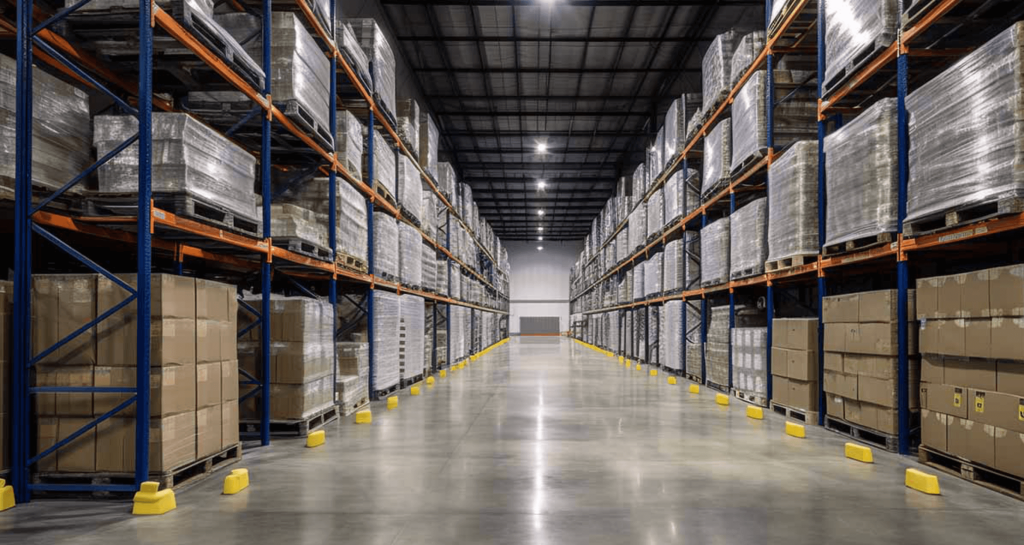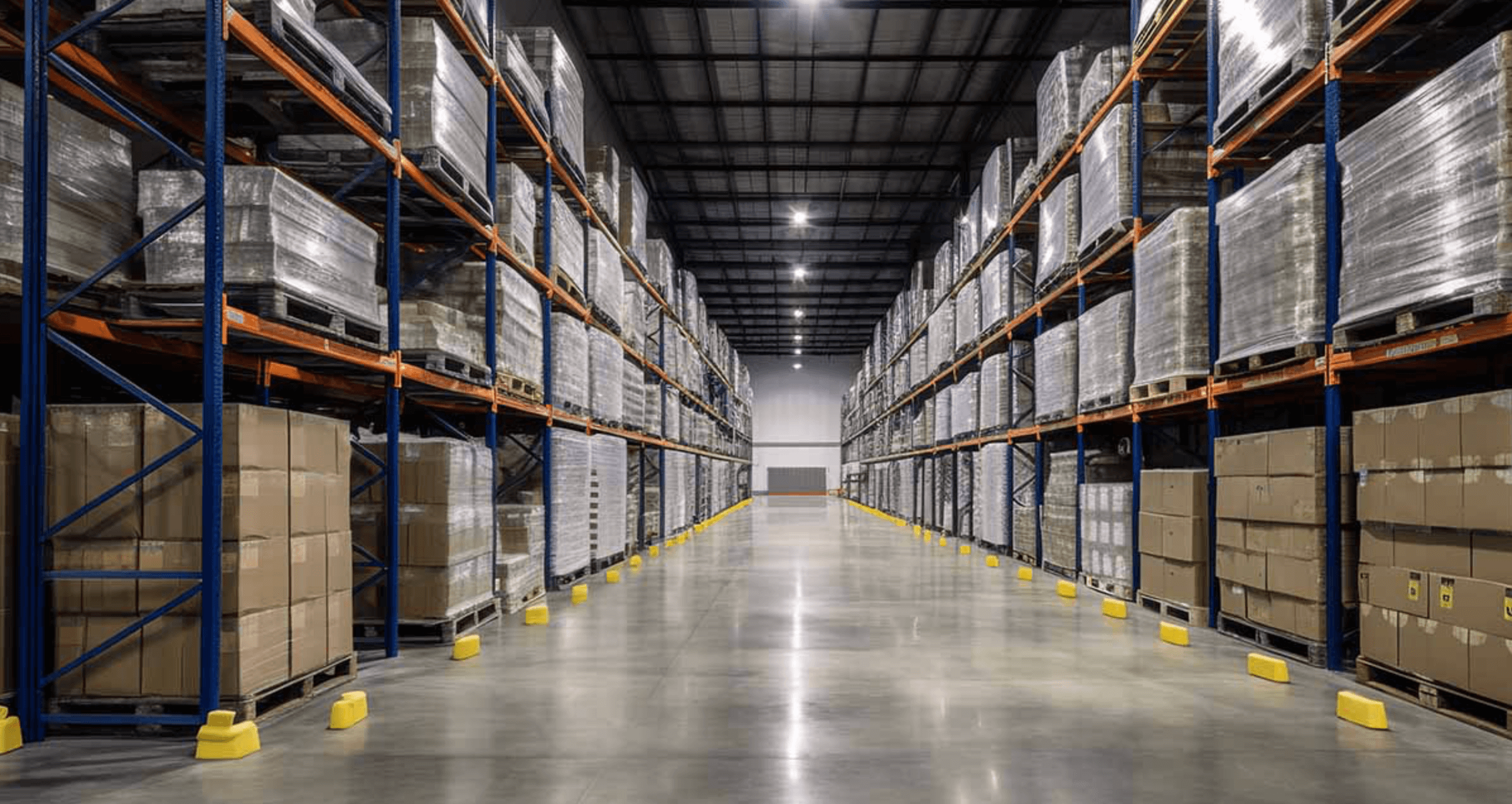Efficient warehousing is the backbone of many successful businesses. Whether you’re dealing with perishable goods or sensitive electronics, maintaining a controlled environment in your warehouse can make all the difference in product quality and lifespan. This blog post will guide you through the strategies and best practices for achieving optimal warehousing efficiency, ensuring your products remain in peak condition from storage to shipment.

Why Controlled Environments Matter?
In an era where customer expectations are soaring, maintaining a controlled environment in your warehouse is more critical than ever. Controlled environments ensure that products are stored in optimal conditions, preventing degradation and extending shelf life. For businesses engaged in contract manufacturing, this is especially vital since they are responsible for producing and delivering high-quality products.
A controlled environment helps in maintaining the integrity of sensitive products, from pharmaceuticals to food items. It ensures that temperature, humidity, and other factors remain consistent, reducing the risk of spoilage or damage. This not only prevents financial loss but also upholds a company’s reputation for quality.
Furthermore, by investing in controlled environments, companies can boost their operational efficiency. With fewer product losses, businesses can streamline their inventory management, reduce waste, and ultimately save on costs. It’s a win-win situation that benefits both the business and the consumer.
Assessing Your Current Warehouse Setup
Before implementing changes, it’s crucial to assess your current warehouse setup. This provides a baseline that helps identify areas of improvement. Start by examining the layout of your warehouse. Is it designed to maximize space and efficiency? A well-organized warehouse allows for easy access to products and reduces the time needed for pick and pack operations.
Next, evaluate the environmental controls in place. Are your temperature and humidity levels consistent throughout the warehouse? Inconsistent conditions can lead to product degradation, especially for sensitive items. Consider investing in technology that monitors and adjusts environmental factors automatically.
Lastly, review your existing inventory management practices. Are there systems in place to track and monitor product conditions? Inventory management systems that integrate with environmental control systems offer real-time data, enabling proactive decision-making and reducing the risk of product damage.
Implementing Temperature Control Solutions
Temperature control is a fundamental aspect of maintaining a controlled environment. For many products, even a slight fluctuation in temperature can lead to spoilage or damage. Therefore, investing in reliable temperature control solutions is essential for any efficient warehouse.
Begin with installing high-quality HVAC systems that can maintain consistent temperature levels. Regular maintenance of these systems ensures they operate at peak efficiency. Additionally, consider using industrial fans and ventilation systems to ensure even air distribution throughout the warehouse.
Another effective solution is the use of thermal curtains or barriers. These barriers help maintain separate temperature zones within a warehouse, allowing for more precise control. They are particularly useful in warehouses storing different types of products with varying temperature requirements.
The Role of Humidity Control
Just as temperature is critical, so too is humidity control. Excess moisture in the air can lead to mold growth, corrosion, and product spoilage, particularly in food and pharmaceutical industries. Implementing effective humidity control solutions is key to preserving product quality.
Dehumidifiers are an excellent tool for maintaining optimal humidity levels. They remove excess moisture from the air, ensuring a dry and stable environment. Ensure that dehumidifiers are regularly serviced to maintain their effectiveness.
It’s also beneficial to invest in humidity sensors that provide real-time data. These sensors can alert staff to any fluctuations in humidity, allowing for quick adjustments. By being proactive, companies can prevent potential product damage and maintain a controlled environment.
Optimizing Air Quality
Air quality is often overlooked in warehouse environments, yet it plays a significant role in product preservation. Poor air quality can introduce contaminants that compromise the integrity of stored goods. Implementing measures to maintain high air quality can extend product life and enhance operational efficiency.
Air filtration systems are a must-have for any warehouse. They remove dust, allergens, and other contaminants from the air, ensuring a clean environment. Regular filter replacements are crucial to maintaining their effectiveness.
Additionally, consider implementing air circulation systems to prevent stagnation. Proper air circulation helps maintain consistent temperature and humidity levels throughout the warehouse. This not only preserves product quality but also creates a healthier work environment for employees.
Energy Efficiency for Cost Savings
Maintaining a controlled environment can be energy-intensive, leading to higher operational costs. However, by implementing energy-efficient practices, companies can reduce expenses while still ensuring optimal conditions for their products.
Start by conducting an energy audit of your warehouse. Identify areas where energy use can be reduced, such as through improved insulation or more efficient lighting systems. Upgrading to LED lighting, for example, can significantly cut energy costs while providing adequate illumination.
Consider investing in energy-efficient HVAC systems and monitoring solutions. These systems can automatically adjust settings based on real-time data, ensuring consistent conditions while minimizing energy use. The initial investment may be substantial, but the long-term savings make it worthwhile.
Inventory Management and Technology Integration
Effective inventory management is crucial for maintaining a controlled environment. By integrating technology into inventory systems, companies can track product conditions in real-time, ensuring that products remain in optimal condition.
Inventory management software can provide valuable insights into stock levels, expiration dates, and environmental conditions. Integrating this software with environmental control systems allows for automated adjustments, reducing the risk of product spoilage.
Investing in RFID technology is another beneficial strategy. RFID tags provide real-time data on product location and condition, streamlining inventory management and ensuring that products are stored and handled correctly.
Employee Training and Best Practices
Even with the best systems in place, the success of a controlled environment relies on employee awareness and training. Employees should be well-versed in the importance of maintaining specific conditions and how to operate the equipment designed to regulate these conditions.
Regular training sessions ensure that staff are up-to-date with best practices and new technologies. This not only enhances operational efficiency but also empowers employees to take ownership of maintaining a controlled environment.
Encourage a culture of accountability and vigilance. By fostering an environment where employees feel responsible for product quality, companies can ensure that standards are consistently met.
Adapting to Seasonal Changes
Seasonal changes can significantly impact warehouse environments. Fluctuations in temperature and humidity pose challenges in maintaining consistent conditions. Anticipating and preparing for these changes can mitigate their effects on product quality.
Conduct seasonal assessments of your warehouse systems to ensure they are ready for the changes ahead. Adjust environmental controls accordingly and ensure that all equipment is functioning optimally.
Consider implementing seasonal best practices, such as adjusting storage layouts or increasing monitoring frequencies during peak season changes. By being proactive, companies can maintain a controlled environment year-round.
Leveraging Technology for Automation
Automation can significantly enhance the efficiency of maintaining a controlled environment. By leveraging advanced technologies, companies can automate various processes, reducing the need for manual intervention.
Automated systems can monitor environmental conditions and make real-time adjustments to maintain optimal settings. This not only ensures consistent conditions but also frees up staff to focus on other critical tasks.
Investing in IoT (Internet of Things) solutions can further enhance automation efforts. IoT devices provide valuable data insights, enabling companies to optimize operations and improve overall efficiency.
Building Sustainable Warehousing Practices
Sustainability is increasingly becoming a priority for businesses worldwide. Adopting sustainable practices in warehouse operations not only benefits the environment but can also improve efficiency and reduce costs.
Implement energy-saving initiatives, such as using renewable energy sources and sustainable materials in warehouse construction. These practices reduce carbon footprint and demonstrate a commitment to environmental responsibility.
Additionally, consider implementing waste reduction strategies. By minimizing waste and recycling materials, companies can create more sustainable operations while still maintaining a controlled environment.
The Future of Controlled Environment Warehousing
The future of controlled environment warehousing is bright, with technological advancements paving the way for even greater efficiency and precision. Companies that stay ahead of the curve will reap the benefits of enhanced product quality and operational efficiency.
Emerging technologies, such as AI and machine learning, hold significant potential for optimizing warehouse environments. These technologies can analyze vast amounts of data to make predictive adjustments, ensuring optimal conditions at all times.
By staying informed and open to innovation, companies can continue to improve their warehousing practices, setting the stage for future success.
Conclusion
Maintaining a controlled environment in your warehouse is no longer optional; it’s a necessity for businesses looking to remain competitive in today’s market. By implementing the strategies outlined in this blog post, companies can enhance product quality, improve operational efficiency, and reduce costs. For those involved in contract manufacturing, the stakes are even higher, making these practices essential for success.
Remember, a controlled warehouse environment is a dynamic and evolving process. Stay informed, adapt to changes, and leverage technology to ensure your operations remain at the cutting edge. For businesses ready to take the next step, explore further resources and expert consultations to fine-tune your approach to efficient warehousing.

Laura Bennett is a vital member of The Jeep Diva team, handling all review and advertising inquiries. With a strong focus on the latest in celebrity news and entertainment, Laura ensures that each review is insightful and captivating. Her commitment to nurturing advertiser relationships keeps the blog lively and appealing. Outside of work, Laura loves discovering new media and engaging with readers to deliver unique and exciting content to The Jeep Diva audience.

